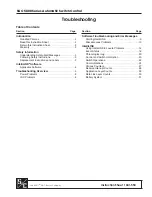
Functional Description
206
SLAU723A – October 2017 – Revised October 2018
Copyright © 2017–2018, Texas Instruments Incorporated
System Control
4.1.5.2.1 Peripheral Clock Sources
In addition to the main clock tree shown in
, the ADC, USB, Ethernet, PWM, UART, and QSSI
all have a clock control register in their register map at offset 0xFC8 that can be used to control the clock
generation for the module.
4.1.5.2.1.1 ADC Clock Control
The ADC digital block is clocked by the system clock and the ADC analog block is clocked from a
separate conversion clock (ADC clock). The ADC clock frequency can be up to 32 MHz to generate a
conversion rate of 2 Msps. A 16-MHz ADC clock provides a 1-Msps sampling rate. There are three
sources for the ADC clock:
•
The PLL VCO (f
VCO
) can be used if the CS bit field is 0x0 in the ADC Clock Configuration (ADCCC)
register and the CLKDIV bit field is configured in the same register.
•
The PIOSC can be used directly to provide a conversion rate near 1 Msps. To use the PIOSC, the CS
field in the ADCCC register must be 0x1, and the ALTCLK field in the Alternate Clock Configuration
(ALTCLKCFG) register must be 0x0.
•
The MOSC clock source must be 16 MHz for a 1-Msps conversion rate and 32 MHz for a 2-Msps
conversion rate.
NOTE:
If the ADC module is not using the PIOSC as the clock source, the system clock must be at
least 16 MHz.
4.1.5.2.1.2 USB Clock Control
When the USB module uses the integrated USB PHY, the MOSC must be the clock source, either with or
without the PLL, and the system clock must be at least 30 MHz. In addition, only integer divisors should
be used to achieve the 60-MHz USB clock source. Fractional divisors may increase jitter and compromise
USB function. Program the CLKDIV bit field in the USB Clock Control (USBCC) register to specify the
divisor used to reduce the PLL VCO output to the 60-MHz clock source required for the serialization and
deserialization module of the USB controller.
In ULPI mode, if the clock source to the USB is internal, the USB0CLK pin is an output to the external
ULPI PHY. If the USB clock source is external, the USB0CLK pin functions as an input from the external
ULPI PHY.
4.1.5.2.1.3 Ethernet Clock Control
Available clock sources are dependent on the interface chosen. The following sections describe the clock
control for the various interfaces.
The Ethernet Controller module and integrated PHY receive two clock inputs. A gated system clock acts
as the clock source to the CSRs of the Ethernet MAC and must be 20 MHz or greater for correct
operation. The SYSCLK frequency for run, sleep, and deep-sleep modes is programmed in the System
Control module. See
for more information.
4.1.5.2.1.3.1 PHY Interface Clocking
The Ethernet Controller module and Integrated PHY receive two clock inputs (see
for
more information):
•
A gated system clock acts as the clock source to the CSRs of the Ethernet MAC. The SysClk
frequency for run, sleep, and deep-sleep modes is programmed in the System Control module.
•
The PHY receives the MOSC, which must be 25 MHz ±50 ppm for proper operation. The MOSC
source can be a single-ended source or a crystal.
4.1.5.2.1.3.2 MII Interface Clocking
Four clock inputs are driven into the Ethernet MAC when the MII configuration is enabled. The clocks are
described as follows (see
for more information):
















































